Reading view
Blessed Hope
 Who gave himself for us, that he might redeem us from all iniquity, and purify unto himself a peculiar people, zealous of good works.
Who gave himself for us, that he might redeem us from all iniquity, and purify unto himself a peculiar people, zealous of good works. SCOTUS Makes my Day and Limits EPA Takeover
 The discription of Sacketts Property is so similar to Property I own. Thank You Sacketts. Thank-You SCOtUS
The discription of Sacketts Property is so similar to Property I own. Thank You Sacketts. Thank-You SCOtUS 18 Nov 2022 Red Line -Another day of Infinity
 Another Red Line. Biden has no Red Line and his DOJ is no better.
Another Red Line. Biden has no Red Line and his DOJ is no better. Death, Burial, and Resurrection of Jesus Christ
 And, behold, the veil of the temple was rent in twain from the top to the bottom; and the earth did quake, and the rocks rent;
And, behold, the veil of the temple was rent in twain from the top to the bottom; and the earth did quake, and the rocks rent; Danwillie’s Websites Forsale and USE
Weekly Update 454

We're two weeks in from the launch of the new HIBP, and I'm still recovering. Like literally still recovering from the cold I had last week and the consequent backlog. A major launch like this isn't just something you fire and forget; instead, it takes weeks of tweaks and refinements to iron out all the little creases, both known and unpredictable. None of them have been significant, fortunately, but the more I look at it, the more I see, and the more we refine. This week, we're diving headfirst into something I'd rather avoid: wacky procurement demands. Stuff like quote generation so that you can have the same stuff as you can find on the pricing page right now, just as a PDF with your name on it 🤦♂️ And look, I get it - it's not the people reading this making those demands and I have tread in your shoes and felt your pain. Hopefully, sometime this week, we'll automate away both your and my pain, and that'll be a massive step forward for all of us. Stay tuned!
References
- Sponsored by: Report URI: Guarding you from rogue JavaScript! Don’t get pwned; get real-time alerts & prevent breaches #SecureYourSite
- I'm coming to Zurich! (now at the correct date of June 16)
- The Fédération Francaise de Rugby breach turned up (282k people in there, including with their DoBs for some reason 🤷♂️)
- Sticking with the French theme, their "Free" ISP data popped up too (another 14M people there, also with dates of birth 🤷♂️)
- And the second coming of Operation Endgame also made its way to HIBP (with support from our friends in LEA 👮)
Weekly Update 453
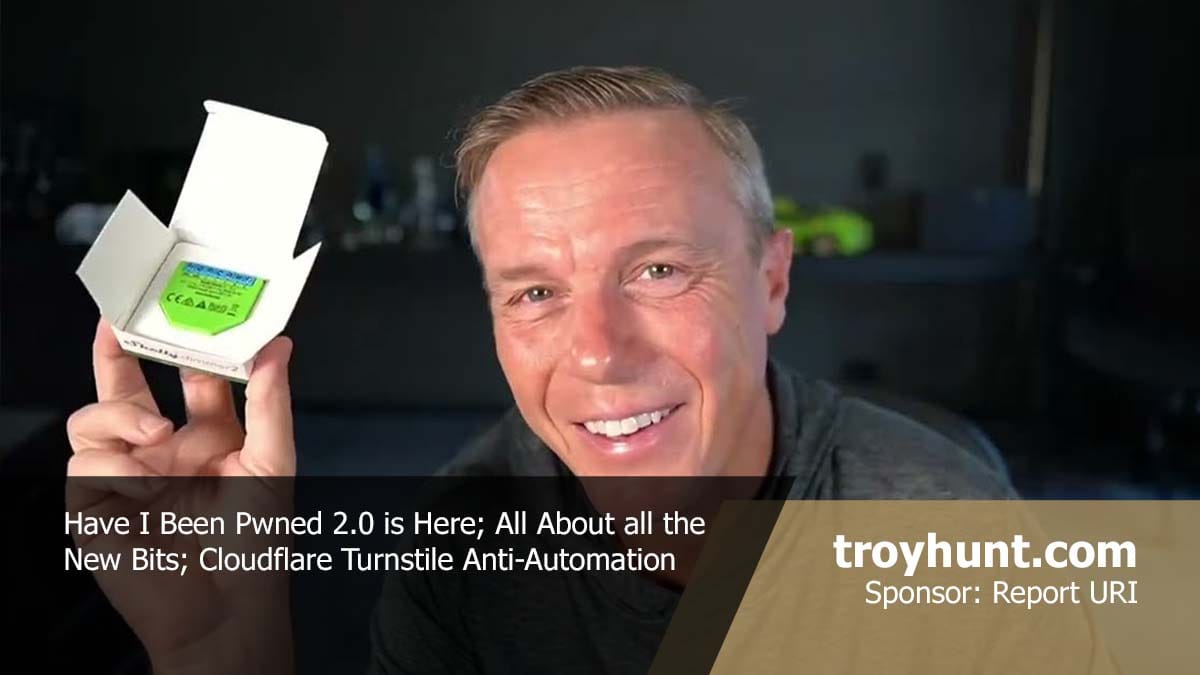
Well, the last few weeks of insane hours finally caught up with me 🤒 Not badly, but I evidently burned enough midnight oil to leave the immune system somewhat degraded and just after recording this video, I really didn't feel like doing much at all. Some congestion and sniffles aside, it's really not that bad, but definitely evidence of a very intense period, which thankfully, is now behind us. So, this week, let's talk about that awesome new HIBP website 😊
References
- Sponsored by: Report URI: Guarding you from rogue JavaScript! Don’t get pwned; get real-time alerts & prevent breaches #SecureYourSite
- We launched! (the end of one era, the beginning of another)
- Cloudflare's Turnstile is protecting a bunch of features in the new HIBP site from automation (but we do need to work on the rate at which it thinks real people are bots)
- I later put out a poll on the rate at which Turnstile was blocking access (when I speculated about 10%, I was pretty close - it's actually 8.7%)
Have I Been Pwned 2.0 is Now Live!
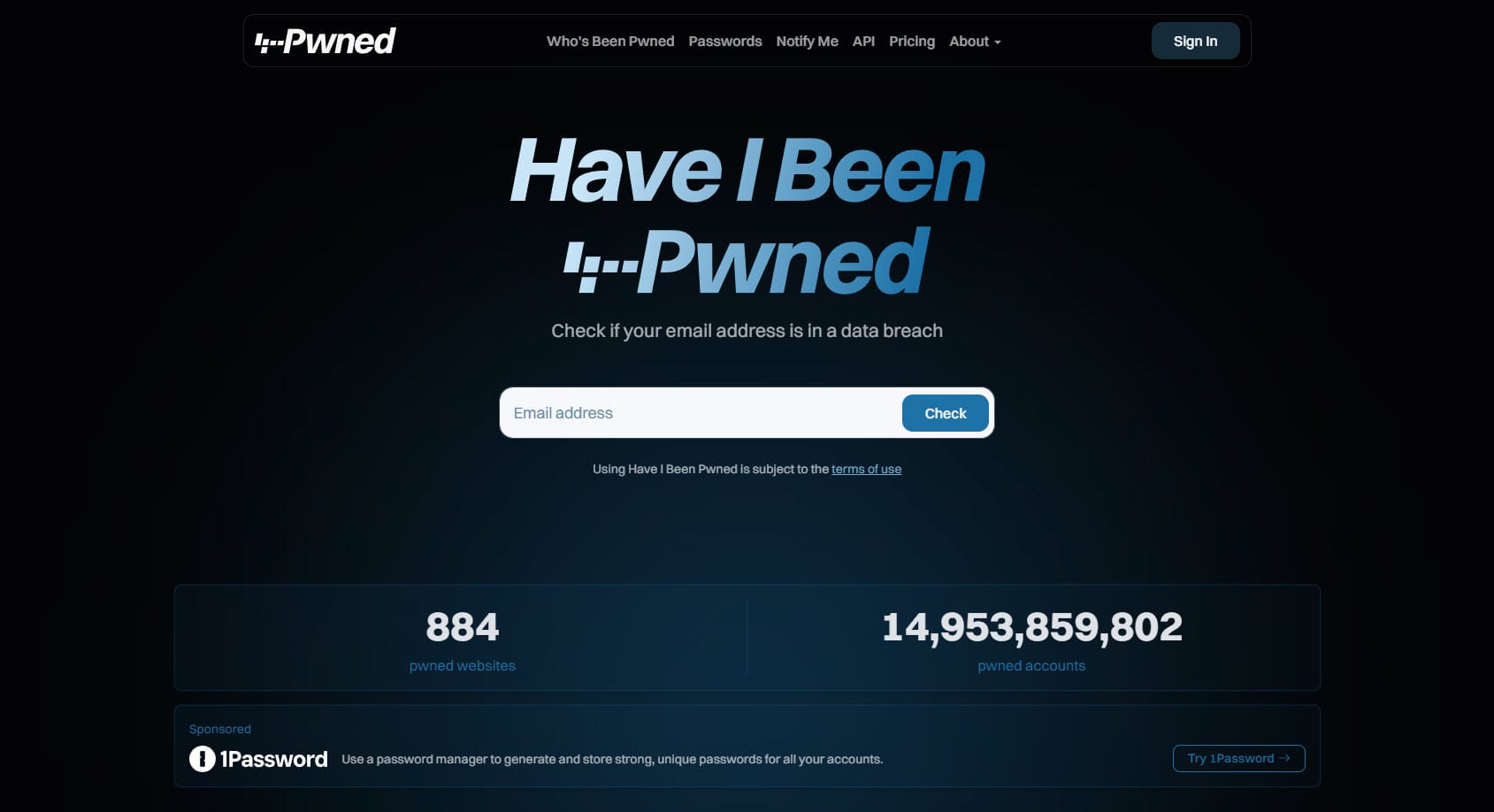
This has been a very long time coming, but finally, after a marathon effort, the brand new Have I Been Pwned website is now live!

Feb last year is when I made the first commit to the public repo for the rebranded service, and we soft-launched the new brand in March of this year. Over the course of this time, we've completely rebuilt the website, changed the functionality of pretty much every web page, added a heap of new features, and today, we're even launching a merch store 😎
Let me talk you through just some of the highlights, strap yourself in!
The Search
The signature feature of HIBP is that big search box on the front page, and now, it's even better - it has confetti!

Well, not for everyone, only about half the people who use it will see a celebratory response. There's a reason why this response is intentionally jovial, let me explain:
As Charlotte and I have travelled and spent time with so many different users of the service around the world, a theme has emerged over and over again: HIBP is a bit playful. It's not a scary place emblazoned with hoodies, padlock icons, and fearmongering about "the dark web". Instead, we aim to be more consumable to the masses and provide factual, actionable information without the hyperbole. Confetti guns (yes, there are several, and they're animated) lighten the mood a bit. The alternative is that you get the red response:

There was a very brief moment where we considered a more light-hearted treatment on this page as well, but somehow a bit of sad trombone really didn't seem appropriate, so we deferred to a more demure response. But now it's on a timeline you can scroll through in reverse chronological order, with each breach summarising what happened. And if you want more info, we have an all-new page I'll talk about in a moment.
Just one little thing first - we've dropped username and phone number search support from the website. Username searches were introduced in 2014 for the Snapchat incident, and phone number searches in 2021 for the Facebook incident. And that was it. That's the only time we ever loaded those classes of data, and there are several good reasons why. Firstly, they're both painful to parse out of a breach compared to email addresses, which we simply use a regex to extract (we've open sourced the code that does this). Usernames are a string. Phone numbers are, well, it depends. They're not just numbers because if you properly internationalise them (like they were in the Facebook incident), they've also got a plus at the front, but they're frequently all over the place in terms of format. And we can't send notifications because nobody "owns" a username, and phone numbers are very expensive to send SMSs to compared to sending emails. Plus, every other incident in HIBP other than those two has had email addresses, so if we're asking "have I been pwned?" we can always answer that question without loading those two hard-to-parse fields, which usually aren't present in most breaches anyway. When the old site offered to accept them in the search box, it created confusion and support overhead: "why wasn't my number in the [whatever] breach?!". That's why it's gone from the website, but we've kept it supported on the API to ensure we don't break anything... just don't expect to see more data there.
The Breach Page
There are many reasons we created this new page, not least of which is that the search results on the front page were getting too busy, and we wanted to palm off the details elsewhere. So, now we have a dedicated page for each breach, for example:

That's largely information we had already (albeit displayed in a much more user-friendly fashion), but what's unique about the new page is much more targeted advice about what to do after the breach:

I recently wrote about this section and how we plan to identify other partners who are able to provide appropriate services to people who find themselves in a breach. Identity protection providers, for example, make a lot of sense for many data breaches.
Now that we're live, we'll also work on fleshing this page out with more breach and user-specific data. For example, if the service supports 2FA, then we'll call that out specifically rather than rely on the generic advice above. Same with passkeys, and we'll add a section for that. A recent discussion with the NCSC while we were in the UK was around adding localised data breach guidance, for example, showing folks from the UK the NCSC logo and a link to their resource on the topic (which recommends checking HIBP 🙂).
I'm sure there's much more we can do here, so if you've got any great ideas, drop me a comment below.
The Dashboard
Over the course of many years, we introduced more and more features that required us to know who you were (or at least that you had access to the email address you were using). It began with introducing the concept of a sensitive breach during the Ashley Madison saga of 2015, which meant the only way to see your involvement in that incident was to receive an email to the address before searching. (Sidenote: There are many good reasons why we don't do that on every breach.) In 2019, when I put an auth layer around the API to tackle abuse (which it did beautifully!) I required email verification first before purchasing a key. And more things followed: a dedicated domain search dashboard, managing your paid subscription and earlier this year, viewing stealer logs for your email address.
We've now unified all these different places into one central dashboard:

From a glance at the nav on the left, you can see a lot of familiar features that are pretty self-explanatory. These combine relevant things for the masses and those that are more business-oriented. They're now all behind the one "Sign In" that verifies access to the email address before being shown. In the future, we'll also add passkey support to avoid needing to send an email first.
The dashboard approach isn't just about moving existing features under one banner; it will also give us a platform on which to build new features in the future that require email address verification first. For example, we've often been asked to provide people with the ability to subscribe their family's email addresses to notifications, yet have them go to a different address. Many of us play tech support for others, and this would be a genuinely useful feature that makes sense to place at a point where you've already verified your email address. So, stay tuned for that one, among many others.
The Domain Search Feature
More time went into this one feature than most of the other ones combined. There's a lot we've tried to do here, starting with a much cleaner list of verified domains:

The search results now give a much cleaner summary and add filtering by both email address and a hotly requested new feature - just the latest breach (it's in the drop-down):

All those searches now just return JSON from APIs and the whole dashboard acts as a single-page app, so everything is really snappy. The filtering above is done purely client-side against the full JSON of the domain search, an approach we've tested with domains of over a quarter million breached email addresses and still been workable (although arguably, you really want that data via the API rather than scrolling through it in a browser window).
Verification of domain ownership has also been completely rewritten and has a much cleaner, simpler interface:

We still have work to do to make the non-email verification methods smoother, but that was the case before, too, so at least we haven't regressed. That'll happen shortly, promise!
The API
First things first: there have been no changes to the API itself. This update doesn't break anything!
There's a discussion over on the UX rebuild GitHub repo about the right way to do API documentation. The general consensus is OpenAPI and we started going down that route using Scalar. In fact, you can even see the work Stefan did on this here at haveibeenpwned.com/scalar:

It's very cool, especially the way it documents samples in all sorts of different languages and even has a test runner, which is effectively Postman in the browser. Cool, but we just couldn't finish it in time. As such, we've kept the old documentation for now and just styled it so it looks like the rest of the site (which I reckon is still pretty slick), but we do intend to roll to the Scalar implementation when we're not under the duress of such a big launch.
The Merch Store
You know what else is awesome? Merch! No, seriously, we've had so many requests over the years for HIBP branded merch and now, here we are:

We actually now have a real-life merch store at merch.haveibeenpwned.com! This was probably the worst possible use of our time, considering how much mechanical stuff we had to do to make all the new stuff work, but it was a bit of a passion project for Charlotte, so yeah, now you can actually buy HIBP merch. It's all done through Teespring (where have I heard that name before?!) and everything listed there is at cost price - we make absolutely zero dollars, it's just a fun initiative for the community 🙂
We did try out their option for stickers too, but they fell well short of what we already had up with our little one-item store on Sticker Mule so for now, that remains the go-to for laptop decorations. Or just go and grab the open source artwork and get your own printed from wherever you please.
The Nerdy Bits
We still run the origin services on Microsoft Azure using a combination of the App Service for the website, "serverless" Functions for most APIs (there are still a few async ones there that are called as a part of browser-based features), SQL Azure "Hyperscale" and storage account features like queues, blobs and tables. Pretty much all the coding there is C# with .NET 9.0 and ASP.NET MVC on .NET Core for the web app. Cloudflare still plays a massive role with a lot of code in workers, data in R2 storage and all their good bits around WAF and caching. We're also now exclusively using their Turnstile service for anti-automation and have ditched Google's reCAPTCHA completely - big yay!
The front end is now latest gen Bootstrap and we're using SASS for all our CSS and TypeScript for all our JavaScript. Our (other) man in Iceland Ingiber has just done an absolutely outstanding job with the interfaces and exceeded all our expectations by a massive margin. What we have now goes far beyond what we expected when we started this process, and a big part of that has been Ingiber's ability to take a simple requirement and turn it into a thing of beauty 😍 I'm very glad that Charlotte, Stefan and I got to spend time with him in Reykjavik last month and share some beers.
We also made some measurable improvements to website performance. For example, I ran a Pingdom website speed test just before taking the old one offline:

And then ran it over the new one:

So we cut out 28% of the page size and 31% of the requests. The load time is much of a muchness (and it's highly variable at that), but having solid measures for all the values in the column on the right is a very pleasing result. Consider also the commentary anyone in web dev would have seen over the years about how much bigger web pages have become, and here we are shaving off solid double-digit percentages 11 years later!
Finally, anything that could remotely be construed as tracking or ad bloat just isn't there, because we simply don't do any of that 🙂 In fact, the only real traffic stats we have are based on what Cloudflare sees when the traffic flows through their edge nodes. And that 1Password product placement is, as it's always been, just text and an image. We don't even track outbound clicks, that's up to them if they want to capture that on the landing page we link to. This actually makes discussions such as we're having with identity theft companies that want product placement much harder as they're used to getting the sorts of numbers that invasive tracking produces, but we wouldn't have it any other way.
The AI
I wanted to make a quick note of this here, as AI seems to be either constantly overblown or denigrated. Either it's going to solve the world's problems, or it just produces "slop". I used Chat GPT in particular really extensively during this rebuild, especially in the final days when time got tight and my brain got fried. Here are some examples where it made a big difference:
I'm using Bootstrap icons from here: https://icons.getbootstrap.com/
What's a good icon to illustrate a heading called "Index"?This was right at the 11th hour when we realised we didn't have time to implement Scalar properly, and I needed to quickly migrate all the existing API docs to the new template. There are over 2,000 icons on that page, and this approach meant it took about 30 seconds to find the right one, each and every time.
We killed off some pages on the old site, but before rolling it over, I wanted to know exactly what was there:
Write me a PowerShell script to crawl haveibeenpwned.com and write out each unique URL it findsAnd then:
Now write a script to take all the paths it found and see if they exist on stage.haveibeenpwned.com
It found good stuff too, like the security.txt file I'd forgotten to migrate. It also found stuff that never existed, so it's the usual "trust, but verify" situation.
And just a gazillion little things where every time I needed anything from some CSS advice to configuring Cloudflare rules to idiosyncrasies in the .NET Core web app, the correct answer was seconds away. I'd say it was right 90% of the time, too, and if you're not using AI aggressively in your software development work now (and I'm sure there are much better ways, too) I'm pretty confident in saying "you're doing it wrong".
The Journey Here
It's hard to explain how much has gone into this, and that goes well beyond just what you see in front of you on the website today. It's seemingly little things, like minor revisions to the terms of use and privacy policy, which required many hours of time and thousands of dollars with lawyers (just minor updates to how we process data and a reflection of new services such as the stealer logs).
We pushed out the new site in the wee hours of Sunday morning my time, and almost everything went well:

One or two little glitches that we've fixed and pushed quickly, that's it. I've actually waited until now, 2 days after going live, to publish this post just so we could iron out as much stuff as possible first. We've pushed more than a dozen new releases already since that time, just to keep iterating and refining quickly. TBH, it's been a bit intense and has been an enormously time-consuming effort that's dominated our focus, especially over the last few weeks leading up to launch. And just to drive that point home, I literally got a health alert first thing Monday morning:

Nothing like empirical data to make a point! That last weekend when we went live was especially brutal; I don't think I've devoted that much high-intensity time to a software release for decades.
Have I Been Pwned has been a passion for a quarter of my life now. What I built in 2013 was never intended to take me this far or last this long, and I'm kinda shocked it did if I'm honest. I feel that what we've built with this new site and new brand has elevated this little pet project into a serious service that has a new level of professionalism. But I hope that in reading this, you see that it has maintained everything that has always been great about the service, and I'm so glad to still be here writing about it today in the 205th blog post with that tag. Thanks for reading, now go and enjoy the new website 😊
Edit (a few hours after initially posting): Let me expand on Cloudflare's Turnstile as it'll explain some idiosyncrasies some people have seen:
This is an anti-automation approach that doesn't involve palming traffic to Google (like reCAPTCHA did), and it can be implemented completely invisibly. There are more invasive implementations of it, but we're trying to be seamless here. It involves some Cloudflare script running in the browser and providing a challenge, which is then submitted with the HTTP request and verified server side. We've had it on HIBP in one form or another since 2023, and it can be awesome... until it isn't. If the challenge fails, what happens next? It depends.
On forms where we really need to block the robots (for example, any that send email), a failed Turnstile challenge was initially just showing a red error. It now says this:
Our anti-automation process thinks you're a bot, which you're obviously not! Try behaving like a human and clicking the button again and if it still misbehaves, give the page a reload.
We've often found a second click or a page reload solves the problem, so hopefully this sends people in the right direction. If it doesn't, we'll need to look at more in-your-face implementations of Turnstile that show a widget you need to interact with. To have a go yourself and see it in action, try the dashboard sign in page.
The other place Turnstile features heavily is on the main search page at the root of the site. We don't want that API being hit by bots, so it's a must have there. Here, like on the other pages of the new site, we're asynchronously posting to API endpoints and sending the challenge token along with the request. What we're doing differently on the front page, however, is that if the challenge fails and returns HTTP 401 when posted to the HIBP endpoint (you'll also see a response body of "Invalid Turnstile token"), we were meant to be falling back to a full page post. That wasn't happening in the new site when we first launched it. But it is now 🙂
When the full page post back occurs, Cloudflare will present a managed challenge. This is much more invasive, but it's also much more reliable and will then serve the same result as you would have seen anyway, albeit via a full page load. We implement the same managed challenge logic on the deep-linked account pages, which you can see here: https://haveibeenpwned.com/account/test@example.com
According to the Cloudflare stats, about 82% of all our issued challenges are successfully solved:

Of the 18% that aren't, many will be due to bots stopped by Turnstile doing exactly what it's meant to do. It's likely a single-digit percentage of requests that are real humans being impeded, and we need to look at ways to get that number down, but at least the fallback positions are improved now. If you were having problems, give the site a good refresh, see how you go and leave your feedback in the comments below.
Weekly Update 452
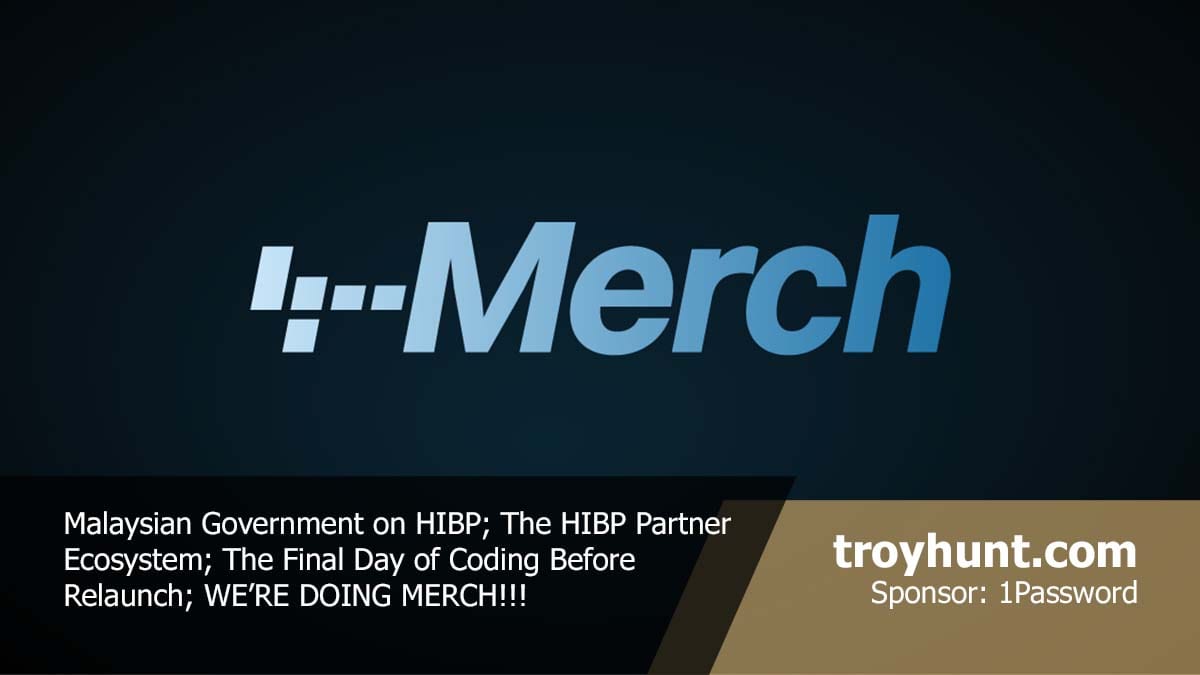
Funny how excited people can get about something as simple as a sticker. They're always in hot demand and occupy an increasingly large portion of my luggage as we travel around. Charlotte reckoned it would be the same for other merch too, so, while I've been beavering away playing code monkey on the rebranded HIBP website, she built a merch store. Talking about it in this week's video obviously got a bunch of people excited, as a flurry of orders followed. As I said in the video, we put everything up there at cost (ok, so Teepsring made us add 1c to each because you couldn't list exactly at cost), so it's just a fun way to enjoy the new HIBP brand more than anything. Enjoy the merch and this week's video, next week we'll have a brand new site live and ready to talk about 😊
References
- Sponsored by: 1Password Extended Access Management: Secure every sign-in for every app on every device.
- Malaysia became our 40th government to take up the HIBP service (actually our first gov from Asia, too)
- We're going to put a small number of carefully selected partners on breach pages in HIBP (we want companies that can add something genuinely useful to breach victims)
- Merch! (what are we missing?)
Welcoming the Malaysian Government to Have I Been Pwned

Today, we welcome the 40th government onboarded to Have I Been Pwned's free gov service, Malaysia. The NC4 NACSA (National Cyber Coordination and Command Centre of the National Cyber Security Agency) in Malaysia now has full access to query all their government domains via API, and monitor them against future breaches.

Malaysia is the first Asian nation to make use of this service, and we look forward to seeing many more from this corner of the world in the future.
Weekly Update 451
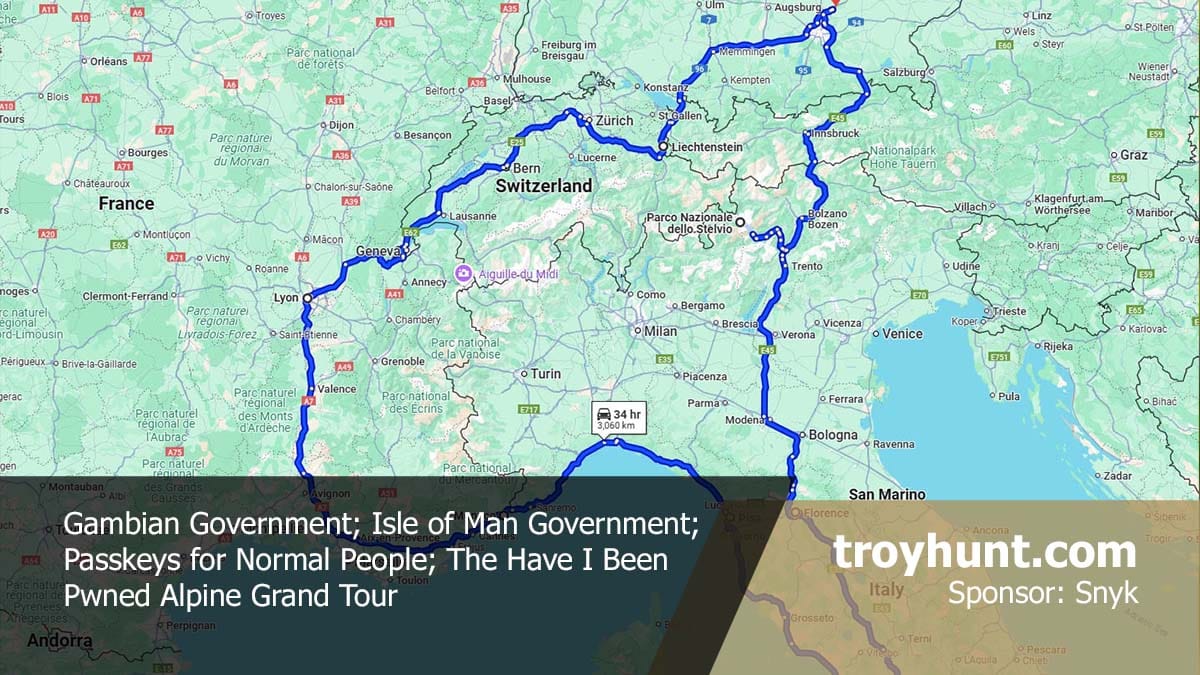
The Have I Been Pwned Alpine Grand Tour is upon us! I've often joked that work is always either sitting at my desk at home in isolation or on the other side of the world, and so it is with this trip. As we've done with recent travel to the US and colder parts of Europe, we've booked to travel to places we know have lots of people we're interested in seeing then we'll fill in the itinerary. Since the blog post last week, we've lined up folks in Leichtenstein, Zurich (which will be a publicly event I'll announce soon), Bern, Geneva and Lyon. I'm still trying to make contact with the folks at CERT-MC in Monaco, and same with the Italian equivalent in Rome. I've planned a bit more time at the latter and would like to try and line up another event like we'll be doing in Zurich so if you're over that way and run a user group or similar, I'd love to hear from you.
References
- Sponsored by: Join Snyk's May 15th event to discover how to establish a Security Champions program, bridging security and development
- If you're interested in a cool panel for putting Home Assistant on the wall somewhere, check out this thread ()
- Gambia's national CSRIT is now the 38th gov on HIBP (they're the first African nation to come on board)
- And the Isle of Man is the 39th (they're a "self-governing British Crown Dependency", so I've learned something new this week)
- Passkeys for normi... normal people! (they can be really simple to setup and use, but that's highly dependent on how the service implements them)
- The HIBP Alpine Grand Tour is next month (summer, the Alps, cyber, what more could you want?! 😄)
After the Breach: Finding new Partners with Solutions for Have I Been Pwned Users
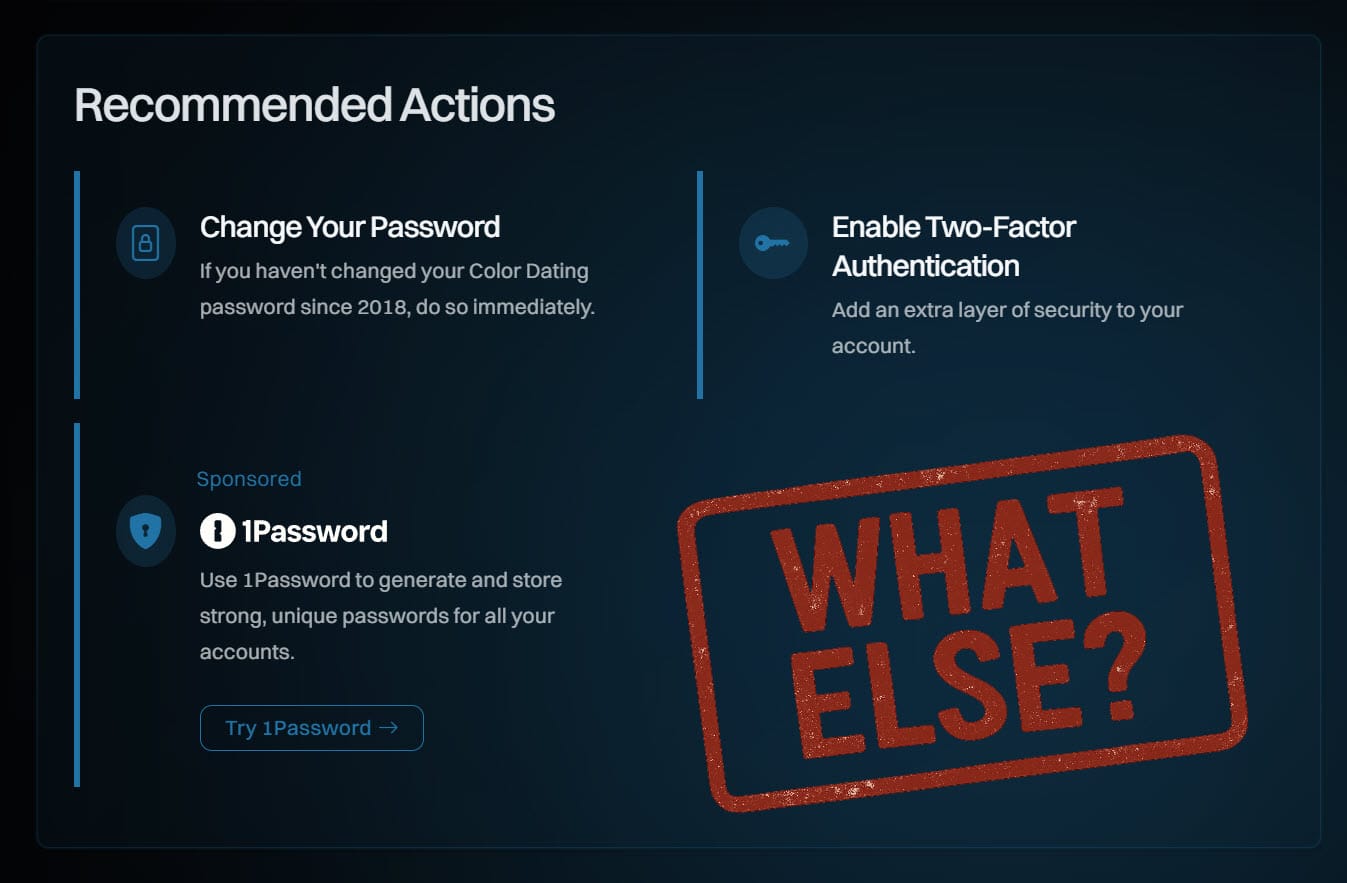
For many years, people would come to Have I Been Pwned (HIBP), run a search on their email address, get the big red "Oh no - pwned!" response and then... I'm not sure. We really didn't have much guidance until we partnered with 1Password and started giving specific advice about how to secure your digital life. So, that's passwords sorted, but the impact of data breaches goes well beyond passwords alone...
There are many different ways people are impacted by breaches, for example, identity fraud. Breaches frequently contain precisely the sort of information that opens the door to impersonation and just taking a quick look at the HIBP stats now, there's a lot of data out there:
- 227 breaches exposed physical address
- 243 breaches exposed date of birth
- 288 breaches exposed phone numbers
That's just the big numbers, then there's the long tail of all sorts of other exposed high-risk data, including partial credit cards (32 breaches), government-issued IDs (18 breaches) and passport numbers (7 breaches). As well as helping people choose good passwords, we want to help them stay safe in the other aspects of their lives put at risk when hackers run riot.
Identity protection services are a good example, and I might be showing my age here, but I've been using them since the 90's. Today, I use a local Aussie one called Truyu which is built by the Commonwealth Bank. Let me give you two examples from them to illustrate why it's a useful service:
The first one came on Melbourne Cup day last year, a day when Aussies traditionally get drunk and lose money betting on horse races. Because gambling (sorry - "gaming") is a heavily regulated industry, a whole bunch of identity data has to be provided if you want to set up an account with the likes of SportsBet. Whilst I personally maintain that gambling is a tax on people who can't do maths, Charlotte was convinced we should have a go anyway, which resulted in Truyu popping up this alert:

This was me (and yes, of course we lost everything we bet) but... what if it wasn't me, and my personal information had been used by someone else to open the account? That's the sort of thing I'd want to know about fast. As for all those "Illion Credit Header" entries, I asked Truyu to help explain what they mean and why they're important to know:
- Illion Credit Header – Banking Finance Segment : This segment includes information that links you to financial institutions—such as banks, lenders, or credit card provider. It helps confirm your financial presence and association with trusted entities, but it can also reveal if your identity is being used across multiple banks fraudulently.
- Illion Credit Header – Telecommunications Segment: This covers data from telco providers (e.g., Optus, Telstra, Vodafone), indicating that your identity has been used to open or inquire about telco services. Telco accounts are often targeted for fraud (SIM swaps, device purchases), so unexpected entries here can flag potential misuse of your ID.
- Illion Credit Header – Utilities Segment - This segment includes information showing you've been associated with utility services like electricity, gas, or water. If someone uses your ID to set up a utility account, it will show here—often before more obvious signs of fraud occur.
- Illion Credit Header – Public Records Segment: This includes any publicly available identity-linked records, such as: Court judgements, Bankruptcies, ASIC or other official listings
Yep, I'd definitely want to know if it wasn't me that initiated all that!
Then, on a recent visit to see the Irish National Cyber Security Centre, we found ourselves hungry in Dublin. Google Maps recommended this epic sushi place, but when we arrived, a sign at the front advised they didn't accept credit cards - in 2025!! Carrying only digital cards, having no cash and being hungry for sushi, I explored the only other avenue the store suggested: creating a Revolut account. Doing so required a bunch of personal information because, like betting, finance is a heavily regulated industry. This earned me another early warning from Truyu about the use of my data:

I pay Truyu A$4.99 each month via a subscription on my iPhone, and IMHO, it's money well spent. For full disclosure, Truyu is also an enterprise subscriber to HIBP (like 1Password is), and you can see breaches we've processed in their app too. I've included them here because they're a great example of a service that adds real value "after the breach", and it's one I genuinely use myself.
The point of all this is that there are organisations out there offering services that are particularly relevant to data breach victims, and we'd like to find the really good ones and put them on the new HIBP website. We've even built out some all-new dedicated spaces, for example on the new breach page:

But choosing partners is a bit more nuanced than that. For example, a service like Truyu caters to an Aussie audience, and the way identity protection works in the US or UK, for example, is different. We need different partners in different parts of the world, and further, offering different services. Identity protection is one thing, but what else? There are many different risks that both individuals and organisations (of which there are hundreds of thousands using HIBP today) face after being in a data breach.
So, we're looking for more partners that can make a positive difference for the folks that land on HIBP, do a search and then ask "now what?!" We're obviously going to be very selective and very cautious about who we work with because the trust people have in HIBP is not something I'll ever jeopardise by selecting the wrong partners. And, of course, any other brand that appears on this site needs to be one that reflects not just our values and mission, but is complementary to our favourite password manager as well.
Now that we're on the cusp of launching this new site (May 17 is our target), I'm inviting any organisations that think they fit the bill to get in touch with me and explain how they can make a positive difference to data breach victims looking for answers "after the breach".
Welcoming the Isle of Man Government to Have I Been Pwned

Today we welcome the 39th government and first self-governing British Crown Dependency to Have I Been Pwned, The Isle of Man. Their Office of Cyber-Security & Information Assurance (OCSIA) now has free and open access to query the government domains of their jurisdiction.
We're delighted and encouraged to see HIBP put to good use across such a wide variety of government use cases and look forward to seeing many more in the future.
Passkeys for Normal People
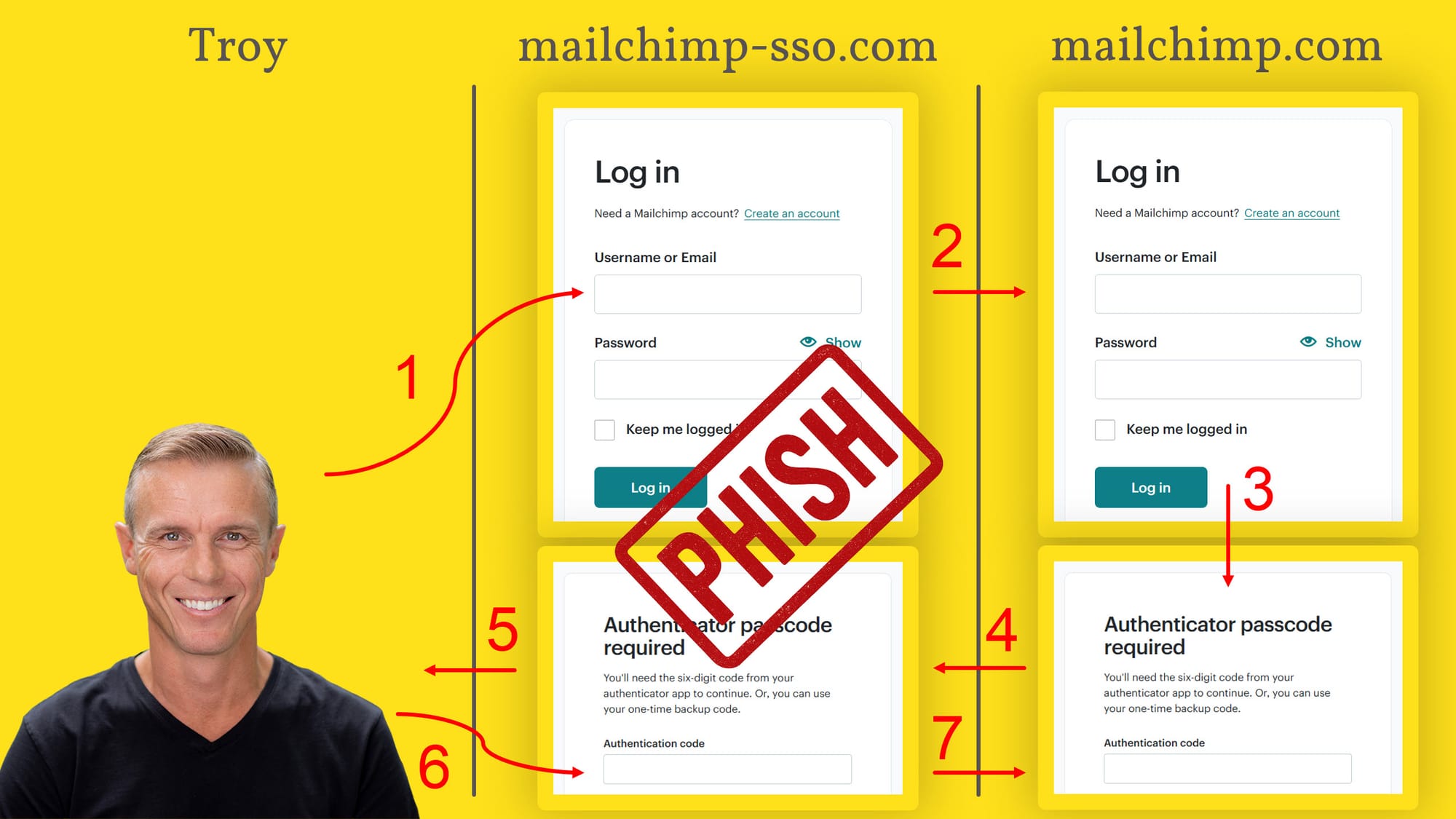
Let me start by very simply explaining the problem we're trying to solve with passkeys. Imagine you're logging on to a website like this:

And, because you want to protect your account from being logged into by someone else who may obtain your username and password, you've turned on two-factor authentication (2FA). That means that even after entering the correct credentials in the screen above, you're now prompted to enter the six-digit code from your authenticator app:

There are a few different authenticator apps out there, but what they all have in common is that they display a one-time password (henceforth referred to as an OTP) with a countdown timer next to it:

By only being valid for a short period of time, if someone else obtains the OTP then they have a very short window in which it's valid. Besides, who can possibly obtain it from your authenticator app anyway?! Well... that's where the problem lies, and I demonstrated this just recently, not intentionally, but rather entirely by accident when I fell victim to a phishing attack. Here's how it worked:

- I was socially engineered into visiting a phishing page that pretended to belong to Mailchimp who I use to send newsletters for this blog. The website address was mailchimp-sso.com, which was close enough to the real address (mailchimp.com) to be feasible. "SSO" is "single sign on", so also seemed feasible.
- When I saw the login screen (the one with the big "PHISH" stamp on it), and submitted my username and password to them, the phishing site then automatically used those credentials to begin the login process on Mailchimp.
- Mailchimp validated the credentials, and because I had 2FA turned on, then displayed the OTP request screen.
- The legitimate OTP screen from Mailchimp was then returned to the bad guys...
- ...who responded to my login request with their own page requesting the OTP.
- I entered the code into the form and submitted it to the phishing site.
- The bad guys then immediately sent that request to Mailchimp, thus successfully logging themselves in.
The problem with OTPs from authenticator apps (or sent via SMS) is that they're phishable in that it's possible for someone to trick you into handing one over. What we need instead is a "phishing-resistant" paradigm, and that's precisely what passkeys are. Let's look at how to set them up, how to use them on websites and in mobile apps, and talk about what some of their shortcomings are.
Passkeys for Log In on Mobile with WhatsApp
We'll start by setting one up for WhatsApp given I got a friendly prompt from them to do this recently:

So, let's "Try it" and walk through the mechanics of what it means to setup a passkey. I'm using an iPhone, and this is the screen I'm first presented with:

A passkey is simply a digital file you store on your device. It has various cryptographic protections in the way it is created and then used to login, but that goes beyond the scope of what I want to explain to the audience in this blog post. Let's touch briefly on the three items WhatsApp describes above:
- The passkey will be used to logon to the service
- It works in conjunction with how you already authenticate to your device
- It needs to be stored somewhere (remember, it's a digital file)
That last point can be very device-specific and very user-specific. Because I have an iPhone, WhatsApp is suggesting I save the passkey into my iCloud Keychain. If you have an Android, you're obviously going to see a different message that aligns to how Google syncs passkeys. Choosing one of these native options is your path of least resistance - a couple of clicks and you're done. However...
I have lots of other services I want to use passkeys on, and I want to authenticate to them both from my iPhone and my Windows PC. For example, I use LinkedIn across all my devices, so I don't want my passkey tied solely to my iPhone. (It's a bit clunky, but some services enable this by using the mobile device your passkey is on to scan a QR code displayed on a web page). And what if one day I switch from iPhone to Android? I'd like my passkeys to be more transferable, so I'm going to store them in my dedicated password manager, 1Password.
A quick side note: as you'll read in this post, passkeys do not necessarily replace passwords. Sometimes they can be used as a "single factor" (the only thing you use to login with), but they may also be used as a "second factor" with the first being your password. This is up to the service implementing them, and one of the criticisms of passkeys is that your experience with them will differ between websites.
We still need passwords, we still want them to be strong and unique, therefore we still need password managers. I've been using 1Password for 14 years now (full disclosure: they sponsor Have I Been Pwned, and often sponsor this blog too) and as well as storing passwords (and credit cards and passport info and secure notes and sharing it all with my family), they can also store passkeys. I have 1Password installed on my iPhone and set as the default app to autofill passwords and passkeys:

Because of this, I'm given the option to store my WhatsApp passkey directly there:

The obfuscated section is the last four digits of my phone number. Let's "Continue", and then 1Password pops up with a "Save" button:

Once saved, WhatsApp displays the passkey that is now saved against my account:

And because I saved it into 1Password that syncs across all my devices, I can jump over to the PC and see it there too.

And that's it, I now have a passkey for WhatsApp which can be used to log in. I picked this example as a starting point given the massive breadth of the platform and the fact I was literally just prompted to create a passkey (the very day my Mailchimp account was phished, ironically). Only thing is, I genuinely can't see how to log out of WhatsApp so I can then test using the passkey to login. Let's go and create another with a different service and see how that experience differs.
Passkeys For Log In via PC with LinkedIn
Let's pick another example, and we'll set this one up on my PC. I'm going to pick a service that contains some important personal information, which would be damaging if it were taken over. In this case, the service has also previously suffered a data breach themselves: LinkedIn.
I already had two-step verification enabled on LinkedIn, but as evidenced in my own phishing experience, this isn't always enough. (Note: the terms "two-step", "two-factor" and "multi-factor" do have subtle differences, but for the sake of simplicity, I'll treat them as interchangeable terms in this post.)

Onto passkeys, and you'll see similarities between LinkedIn's and WhatsApp's descriptions. An important difference, however, is LinkedIn's comment about not needing to remember complex passwords:

Let's jump into it and create that passkey, but just before we do, keep in mind that it's up to each and every different service to decide how they implement the workflow for creating passkeys. Just like how different services have different rules for password strength criteria, the same applies to the mechanics of passkey creation. LinkedIn begins by requiring my password again:

This is part of the verification process to ensure someone other than you (for example, someone who can sit down at your machine that's already logged into LinkedIn), can't add a new way of accessing your account. I'm then prompted for a 6-digit code:

Which has already been sent to my email address, thus verifying I am indeed the legitimate account holder:

As soon as I enter that code in the website, LinkedIn pushes the passkey to me, which 1Password then offers to save:

Again, your experience will differ based on which device and preferred method of storing passkeys you're using. But what will always be the same for LinkedIn is that you can then see the successfully created passkey on the website:

Now, let's see how it works by logging out of LinkedIn and then returning to the login page. Immediately, 1Password pops up and offers to sign me in with my passkey:

That's a one-click sign-in, and clicking the purple button immediately grants me access to my account. Not only will 1Password not let me enter the passkey into a phishing site, due to the technical implementation of the keys, it would be completely unusable even if it was submitted to a nefarious party. Let me emphasise something really significant about this process:
Passkeys are one of the few security constructs that make your life easier, rather than harder.
However, there's a problem: I still have a password on the account, and I can still log in with it. What this means is that LinkedIn has decided (and, again, this is one of those website-specific decisions), that a passkey merely represents a parallel means of logging in. It doesn't replace the password, nor can it be used as a second factor. Even after generating the passkey, only two options are available for that second factor:

The risk here is that you can still be tricked into entering your password into a phishing site, and per my Mailchimp example, your second factor (the OTP generated by your authenticator app) can then also be phished. This is not to say you shouldn't use a passkey on LinkedIn, but whilst you still have a password and phishable 2FA, you're still at risk of the same sort of attack that got me.
Passkeys for 2FA with Ubiquiti
Let's try one more example, and this time, it's one that implements passkeys as a genuine second factor: Ubiquiti.
Ubiquiti is my favourite manufacturer of networking equipment, and logging onto their system gives you an enormous amount of visibility into my home network. When originally setting up that account many years ago, I enabled 2FA with an OTP and, as you now understand, ran the risk of it being phished. But just the other day I noticed passkey support and a few minutes later, my Ubiquiti account in 1Password looked like this:

I won't bother running through the setup process again because it's largely similar to WhatsApp and LinkedIn, but I will share just what it looks like to now login to that account, and it's awesome:
I intentionally left this running at real-time speed to show how fast the login process is with a password manager and passkey (I've blanked out some fields with personal info in them). That's about seven seconds from when I first interacted with the screen to when I was fully logged in with a strong password and second factor. Let me break that process down step by step:
- When I click on the "Email or Username" field, 1Password suggests the account to be logged in with.
- I click on the account I want to use and 1Password validates my identity with Face ID.
- 1Password automatically fills in my credentials and submits the form.
- Ubiquiti asks for my passkey, I click "Continue" and my iPhone uses Face ID again to ensure it's really me.
- The passkey is submitted to Ubiquiti and I'm successfully logged in. (As it was my first login via Chrome on my iPhone, Ubiquiti then asks if I want to trust the device, but that happens after I'm already successfully logged in.)
Now, remember "the LinkedIn problem" where you were still stuck with phishable 2FA? Not so with Ubiquiti, who allowed me to completely delete the authenticator app:

But there's one more thing we can do here to strengthen everything up further, and that's to get rid of email authentication and replace it with something even stronger than a passkey: a U2F key.
Physical Universal 2 Factor Key for 2FA with Ubiquiti
Whilst passkeys themselves are considered non-phishable, what happens if the place you store that digital key gets compromised? Your iCloud Keychain, for example, or your 1Password account. If you configure and manage these services properly then the likelihood of that happening is extremely remote, but the possibility remains. Let's add something entirely different now, and that's a physical security key:
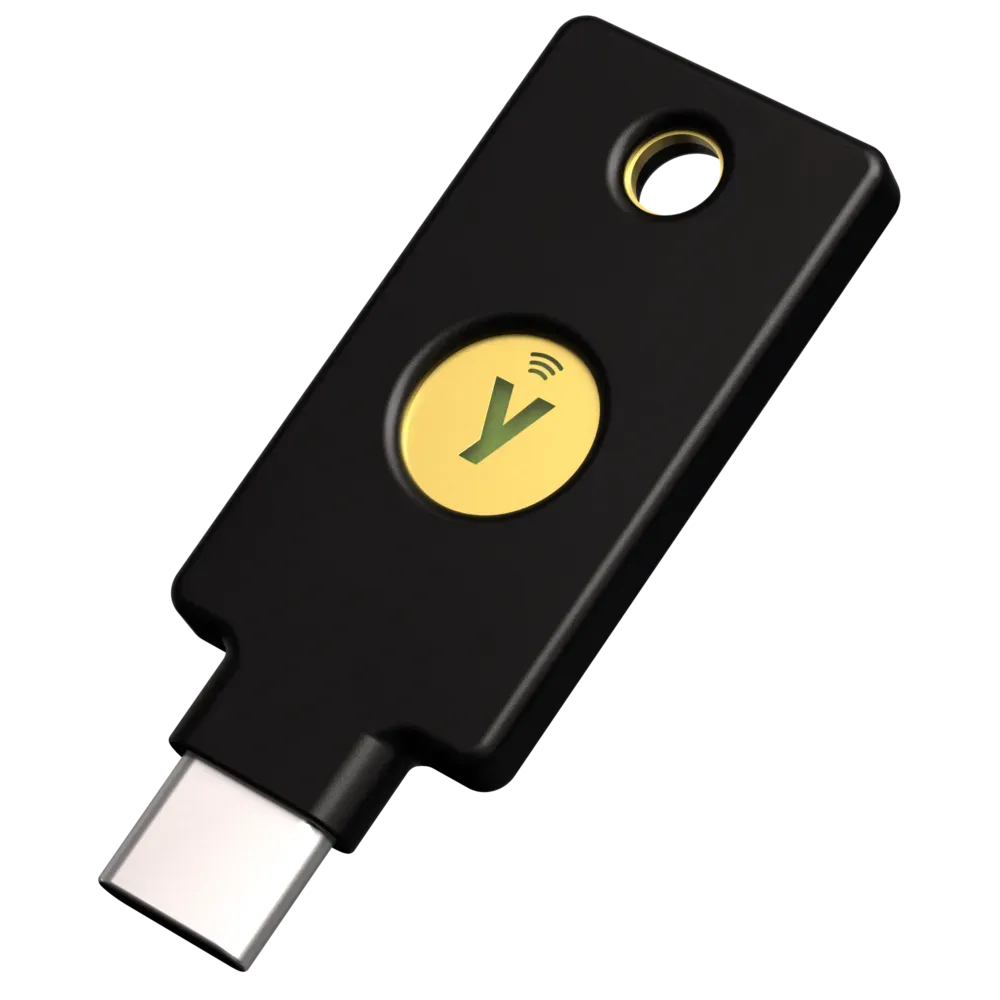
This is a YubiKey and you can you can store your digital passkey on it. It needs to be purchased and as of today, that's about a US$60 investment for a single key. YubiKeys are called "Universal 2 Factor" or U2F keys and the one above (that's a 5C NFC) can either plug into a device with USB-C or be held next to a phone with NFC (that's "near field communication", a short-range wireless technology that requires devices to be a few centimetres apart). YubiKeys aren't the only makers of U2F keys, but their name has become synonymous with the technology.
Back to Ubiquiti, and when I attempt to remove email authentication, the following prompt stops me dead in my tracks:

I don't want email authentication because that involves sending a code to my email address and, well, we all know what happens when we're relying on people to enter codes into login forms 🤔 So, let's now walk through the Ubiquiti process and add another passkey as a second factor:

But this time, when Chrome pops up and offers to save it in 1Password, I'm going to choose the little USB icon at the top of the prompt instead:

Windows then gives me a prompt to choose where I wish to save the passkey, which is where I choose the security key I've already inserted into my PC:

Each time you begin interacting with a U2F key, it requires a little tap:

And a moment later, my digital passkey has been saved to my physical U2F key:

Just as you can save your passkey to Apple's iCloud Keychain or in 1Password and sync it across your devices, you can also save it to a physical key. And that's precisely what I've now done - saved one Ubiquiti passkey to 1Password and one to my YubiKey. Which means I can now go and remove email authentication, but it does carry a risk:

This is a good point to reflect on the paradox that securing your digital life presents: as we seek stronger forms of authentication, we create different risks. Losing all your forms of non-phishable 2FA, for example, creates the risk of losing access to your account. But we also have mitigating controls: your digital passkey is managed totally independently of your physical one so the chances of losing both are extremely low. Plus, best practice is usually to have two U2F keys and enrol them both (I always take one with me when I travel, and leave another one at home). New levels of security, new risks, new mitigations.
Finding Sites That Support Passkeys
All that's great, but beyond my examples above, who actually supports passkeys?! A rapidly expanding number of services, many of which 1Password has documented in their excellent passkeys.directory website:

Have a look through the list there, and you'll see many very familiar brands. You won't see Ubiquiti as of the time of writing, but I've gone through the "Suggest new listing" process to have them added and will be chatting further with the 1Password folks to see how we can more rapidly populate that list.
Do also take a look at the "Vote for passkeys support" tab and if you see a brand that really should be there, make your voice heard. Hey, here's a good one to start voting for:

Summary
I've deliberately just focused on the mechanics of passkeys in this blog post, but let me take just a moment to highlight important separate but related concepts. Think of passkeys as one part of what we call "defence in depth", that is the application of multiple controls to help keep you safe online. For example, you should still treat emails containing links with a healthy suspicion and whenever in doubt, not click anything and independently navigate to the website in question via your browser. You should still have strong, unique passwords and use a password manager to store them. And you should probably also make sure you're fully awake and not jet lagged in bed before manually entering your credentials into a website your password manager didn't autofill for you 🙂
We're not at the very beginning of passkeys, and we're also not yet quite at the tipping point either... but it's within sight. Just last week, Microsoft announced that new accounts will be passwordless by default, with a preference to using passkeys. Whilst passkeys are by no means perfect, look at what they're replacing! Start using them now on your most essential services and push those that don't support them to genuinely take the security of their customers seriously.
Weekly Update 450
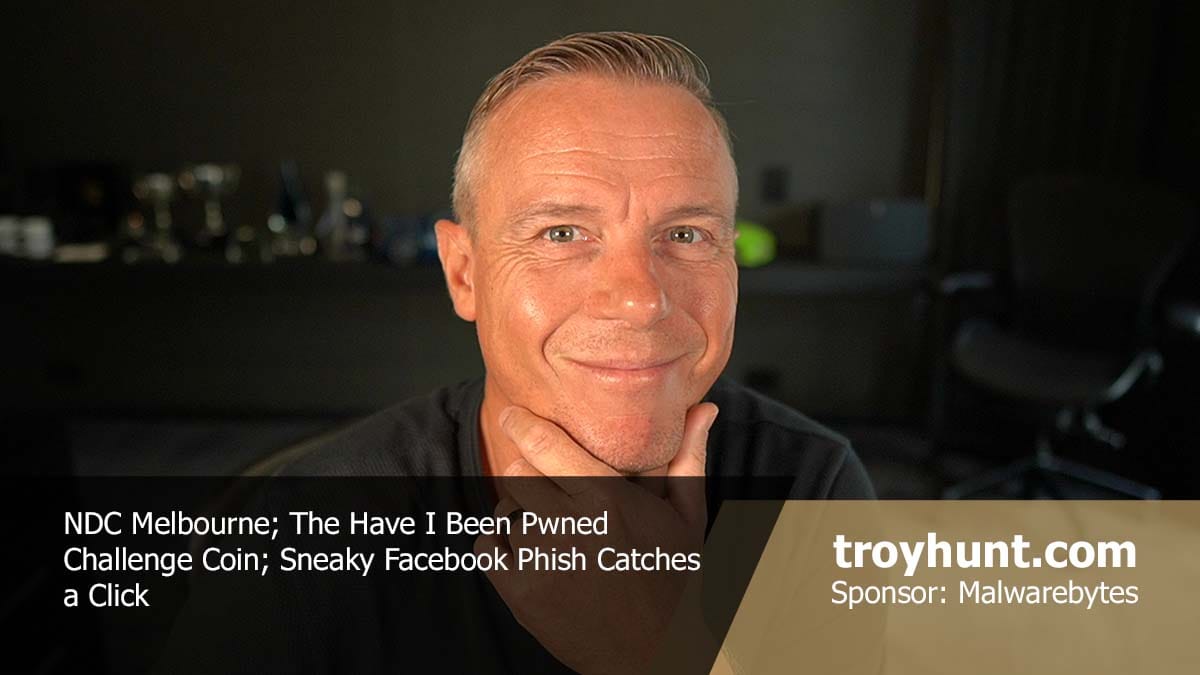
Looking back at this week's video, it's the AI discussion that I think about most. More specifically, the view amongst some that any usage of it is bad and every output is "slop". I'm hearing that much more broadly lately, that AI is both "robbing" creators and producing sub-par results. The latter is certainly true in many cases (although it's improving extraordinarily quickly), but the former is just ridiculous when used as a reason not to use AI. After doing this week's video, I saw press of Satya saying that 30% of code in some Microsoft repositories is written by AI; so, are developers in the same boat? Should we go back to writing more code by hand to keep us more employed? Maybe chuck out all the other efficiency tools we use too - IDEs give way to notepad.exe, and so on. It's kinda nuts.
References
- Sponsored by: Malwarebytes Browser Guard blocks phishing, ads, scams, and trackers for safer, faster browsing
- NDC Melbourne has been run and done (that's actually the last even on my calendar at present, at last until things start filling in for Europe next month)
- We're progressing well with our new Have I Been Pwned challenge coin (but some of the comments about using AI in the process... 😲)
- There is a view amongst some that AI just shouldn't be used for things a human could be paid for (I'm sure a similar discussion was had over and over again during the industrial revolution and, well, every other time tech solved a laborious problem)
- This Facebook phish was way too convincing (largely due to the shock and emotion it created on first read)
The Have I Been Pwned Alpine Grand Tour

I love a good road trip. Always have, but particularly during COVID when international options were somewhat limited, one road trip ended up, well, "extensive". I also love the recent trips Charlotte and I have taken to spend time with many of the great agencies we've worked with over the years, including the FBI, CISA, CCCS, RCMP, NCA, NCSC UK and NCSC Ireland. So, that's what we're going to do next month across some very cool locations in Europe:

Whilst the route isn't set in stone, we'll start out in Germany and cover Liechtenstein, Switzerland, France, Italy and Austria. We have existing relationships with folks in all but one of those locations (France, call me!) and hope to do some public events as we recently have at Oxford University, Reykjavik and even Perth back on (almost) this side of the world. And that's the reason for writing this post today: if you're in proximity of this route and would like to organise an event or if you're a partner I haven't already reached out to, please get in touch. We usually manage to line up a healthy collection of events and assuming we can do that again on this trip, I'll publish them to the events page shortly. There's also a little bit of availability in Dubai on the way over we'll put to productive use, so definitely reach out if you're over that way.
If you're in another part of the world that needs a visit with a handful of HIBP swag, let me know, there's a bunch of other locations on the short list, and we're always thinking about what's coming next 🌍
Welcoming The Gambia National CSIRT to Have I Been Pwned

Today, we're happy to welcome the Gambia National CSIRT to Have I Been Pwned as the 38th government to be onboarded with full and free access to their government domains. We've been offering this service for seven years now, and it enables national CSIRTs to gain greater visibility into the impact of data breaches on their respective nations.
Our goal at HIBP remains very straightforward: to do good things with data breaches after bad things happen. We hope this initiative helps support the Gambia National CSIRT as it has with many other governments around the world.
Weekly Update 449
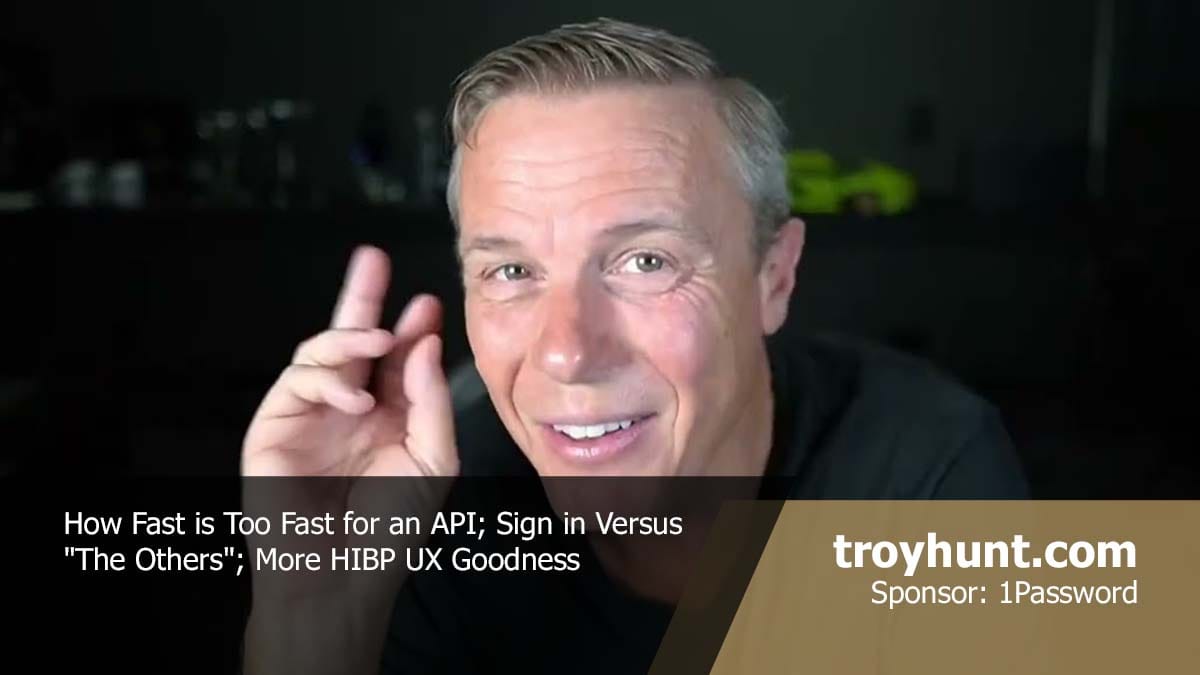
Today, I arrived at my PC first thing in the morning to find the UPS dead (battery was cactus) and the PC obviously without power. So, I tracked down a powerboard and some IEC C14 to mains cable adaptors and powered back up. On boot, neither the Bluetooth mouse nor keyboard worked. So, I tracked down a wired version of each, logged on, didn't find anything weird in the Device Manager, then gave it a reboot, which resulted in the machine not getting past the Lenovo splash screen. So, I rebooted and the same thing happened, unplugged the new USB devices, rebooted again and ended up on the Bitlocker key entry screen. So, on my spare PC I went to my Microsoft account, retrieved the correct key for the disk in question, rebooted and ended up on the recovery screen. So, I ran the recovery process and, much to my surprise, got straight back into Windows.
That's what trying to work out the login / log in / log on / sign in thing was like this week; incrementally shaving the yak until things work and make sense!
References
- Sponsored by: 1Password Extended Access Management: Secure every sign-in for every app on every device.
- The new Pwned Passwords search is actually too fast! (settle down, usability isn't as simple as "always make everything as fast as possible")
- I went down the "login" rabbit hole and emerged with "sign in" (I still feel this was the most logical conclusion to reach)
- Keep those great HIBP UX ideas coming! (May 17 is our go-live date for the new UX, and it's going to be amazing!)
You'll Soon Be Able to Sign in to Have I Been Pwned (but Not Login, Log in or Log On)
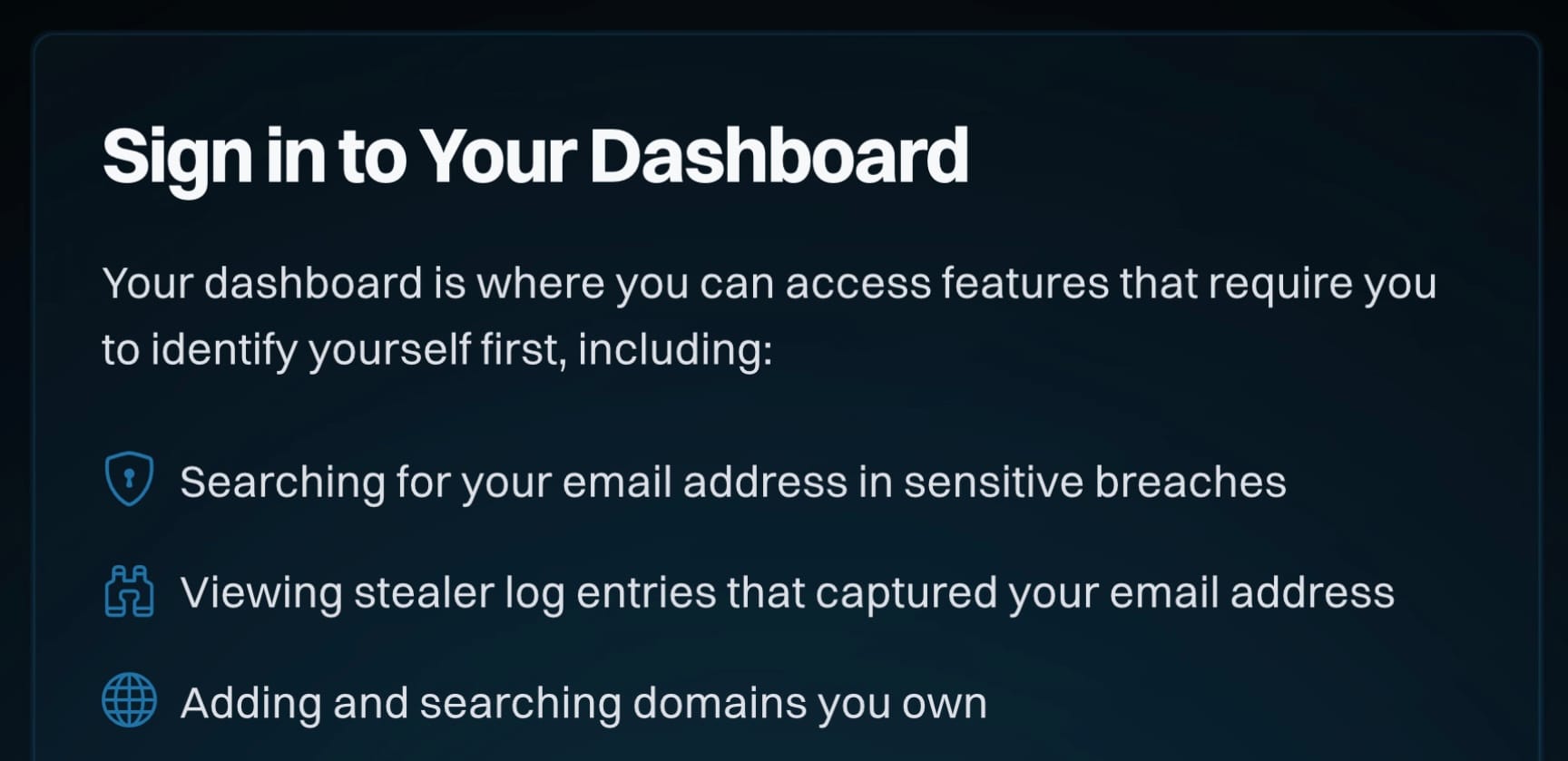
How do seemingly little things manage to consume so much time?! We had a suggestion this week that instead of being able to login to the new HIBP website, you should instead be able to log in. This initially confused me because I've been used to logging on to things for decades:

So, I went and signed in (yep, different again) to X and asked the masses what the correct term was:
When accessing your @haveibeenpwned dashboard, which of the following should you do? Preview screen for reference: https://t.co/9gqfr8hZrY
— Troy Hunt (@troyhunt) April 23, 2025
Which didn't result in a conclusive victor, so, I started browsing around.
Cloudflare's Zero Trust docs contain information about customising the login page, which I assume you can do once you log in:

Another, uh, "popular" site prompts you to log in:

After which you're invited to sign in:

You can log in to Canva, which is clearly indicated by the HTML title, which suggests you're on the login page:

You can log on to the Commonwealth Bank down here in Australia:

But the login page for ANZ bank requires to log in, unless you've forgotten your login details:

Ah, but many of these are just the difference between the noun "login" (the page is a thing) and the verb "log in" (when you perform an action), right? Well... depends who you bank with 🤷♂️

And maybe you don't log in or login at all:

Finally, from the darkness of seemingly interchangeable terms that may or may not violate principles of English language, emerged a pattern. You also sign in to Google:

And Microsoft:

And Amazon:

And Yahoo:

And, as I mentioned earlier, X:

And now, Have I Been Pwned:

There are some notable exceptions (Facebook and ChatGPT, for example), but "sign in" did emerge as the frontrunner among the world's most popular sites. If I really start to overthink it, I do feel that "log[whatever]" implies something different to why we authenticate to systems today and is more a remnant of a bygone era. But frankly, that argument is probably no more valid than whether you're doing a verb thing or a noun thing.



